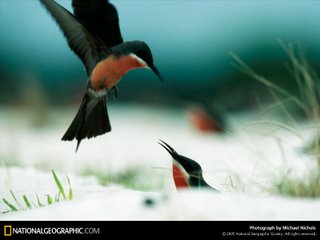I love bee-eaters. I love everything about them, the way they look, the way they fly, the aloof manner in which they puff their feathers when they perch, thus forcing their heads into an upward position. Even the way they eat endears them to me, albeit in a slightly more morbid sense than mere innocent endearment. More on that later.
As you might've guessed by now, bee-eaters are birds. For those who don't know what a bee-eater looks like, this is it
 Picture NOT used with permission by National Geographic. It was a desktop anyway. That's one species of bee-eater from Africa, there're many more species scattered all over the Old World, most in Africa and North Asia. We in Malaysia only get them as migrants, with the exception of the rather dumpy-looking [but exceedingly cute and winning nominee for Animal That Should Be Made Into Soft Toys award] Red- bearded Bee-eater, resident in our primary rainforests. The altogether more conspicuous species more observant people might recognise are winter migrants from north Asia, Malaysia being one of the stops on their way down to Australia, though there are a few which seem to prefer staying here till the flight back. The two most common are the Blue-tailed and Blue-crowned bee-eaters, though there are a handful of Red-crowneds and the occasional Rainbow. Apparently they migrate in flocks, but I've only ever seen them in pairs or individuals.
Picture NOT used with permission by National Geographic. It was a desktop anyway. That's one species of bee-eater from Africa, there're many more species scattered all over the Old World, most in Africa and North Asia. We in Malaysia only get them as migrants, with the exception of the rather dumpy-looking [but exceedingly cute and winning nominee for Animal That Should Be Made Into Soft Toys award] Red- bearded Bee-eater, resident in our primary rainforests. The altogether more conspicuous species more observant people might recognise are winter migrants from north Asia, Malaysia being one of the stops on their way down to Australia, though there are a few which seem to prefer staying here till the flight back. The two most common are the Blue-tailed and Blue-crowned bee-eaters, though there are a handful of Red-crowneds and the occasional Rainbow. Apparently they migrate in flocks, but I've only ever seen them in pairs or individuals.The most conspicuous thing about bee-eaters is their bright colours. Nearly all species have wonderful multi-coloured plumage; the Rainbow literally lives up to it's name. It is strange when you consider the family is closely related to the not altogether very colourful hornbills, but more explicable when you discover they number rollers, kingfishers and hoopoes amongst their other relatives. A stupendously diverse family. The next thing one might notice about them is their long bill, which is understandable given that they live up to their name. In truth bee-eaters eat just about any kind of flying insect, but when bees, hornets and giant wasps number amongst your high-favourites, it is wise that they be kept a comfortable distance from your body before they are dispatched.
The bee-eater's method of feeding highly endears them to me. There's something slightly morbid and thrilled inside me when I'm watching a bird bash its head against the side of a branch repeatedly. The beating motion serves to smash the sting and life out of the prey, rendering it safer to eat. As stated above, bee-eaters tend to use the branches that they perch on for this purpose. Metal might be just as suitable, but apparently the birds haven't really gotten used to that yet. Many a time I have awoken to a tinking sound outside my window. Upon investigation I tend to find a rather fluffed and dazed-looking bee-eater struggling to regain its composure having bashed its pithy meal against a solid metal TV aerial.
The bee-eater comes across to most people as a very sleek bird. It is indeed a very slim-cut creature, the fighter-jet equivalent of the bird world. Its streamlined build is tailored especially for the sharp turns and quick dashes it makes when making brief sallies from its chosen perch, maximising its aerodynamicity and speed. Bee-eaters spend so much time on the wing it seems surprising most people see them at all, indeed they are most conspicuous when perched, and it would be difficult to observe them otherwise. Handily they choose to sit in conspicuous places like in dead trees and atop roofs, so viewers will nearly always get a decent eyeful of the pretty bird. As a bonus, they are for the most part, non-nervous and acclimatised to human presence, so observers will usually be permitted close views.
When bee-eaters are resident [with the exception of the Red-bearded, which is a loner], they tend to mingle in flocks which can number several hundred, and when bee-eaters get together, they do everything together. One of the more spectacular birdwatching sights in Africa is a flock of bee-eaters nesting communally in a riverbank or sandflat, occassionally making brief forays from the cliff face or beach en masse and returning to their nest holes at the same time. It is a lifelong wish to see this sight which will only serve to gladden more my heart and eyes, which for now, continue to be teased by that delightful little green and blue bird, right now flitting to and fro outside my bedroom window, and coyly fluffing its feathers.

0 Comments:
Post a Comment
Subscribe to Post Comments [Atom]
<< Home